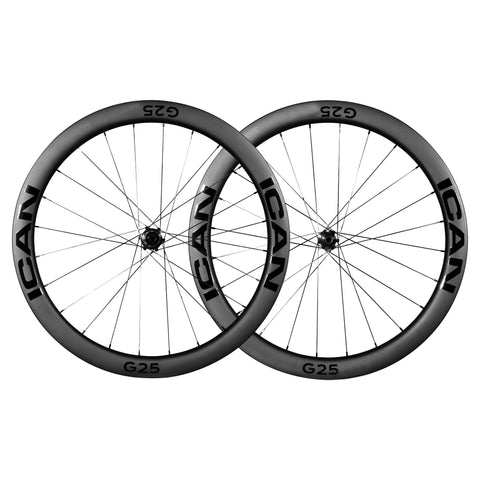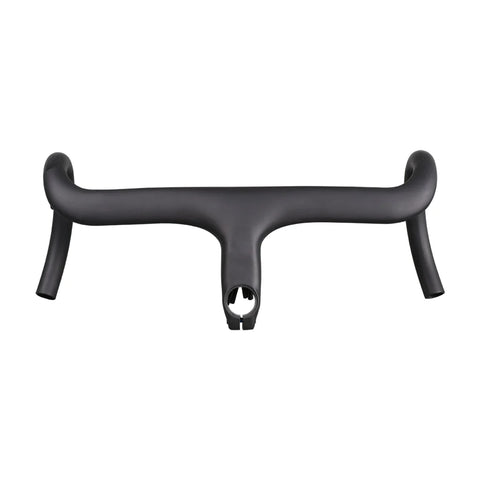Bike Setup Tips
Choose the right tires.
The kind of tire you pick will depend on the ground you intend to ride on if you intend to bike on gravel. A skinnier, low-profile tire that lets more speed—such as a 28mm slick tire—allows for better dirt. You might need a larger 40mm knobby tire, though, if you are working with harder gravel that calls for stronger turning grip and flat prevention.
Lower Your Tire Pressure.
In addition to making the ride more pleasant, low tire pressure improves traction and confidence in ascending and descending. It's advised to explore and experiment since a tubeless wheel/tire combo allows you to run far lower pressure than you would believe. Starting at 35 PSI and progressively lowering (typically below 30 PSI), the rider's weight and terrain control the tire pressure. The handling and feel of the bike can be much changed by even a small PSI variation. Lower tire pressures made possible by ICAN G25's tubeless-ready construction smooth and comfort the ride while reducing the puncture risk.
Choose Suitable Bars.
Look for drop bars with a flared form when seeking bars that provide more comfort and stability for gravel riding. More room for your hands and wrists thanks to the flared form helps you to have a broader grasp and more bike control. To further lower road vibrations, which can cause discomfort and tiredness on long rides, you could also wish to think about handlebars with gel padding or shock-absorbing tape. At last, don't overlook changing the handlebar height and reach to identify the most comfy posture for you.
Gravel Intergrated Handlebar HBG01
To learn more, please refer to Choose The Best Gravel Handlebars 2024 – A Buyer’s Guide.
Ride Preparation
Helmet
Wearing a well-fitted helmet while gravel biking is essential as you may encounter rough terrain, which can cause falls.
Gravel bike repair kit
When you're on a gravel ride, you might find yourself in remote and solitary locations. It's crucial to carry the necessary tools to ensure you're prepared for any situation. Make sure to pack the basics in a saddlebag or frame pack, including extra tubes, tools, pumps, patch kits, and essential nutrition. For longer rides, use a hydration pack or bring extra water bottles.
Essential Inventory for a Gravel Ride:
- Spare Tubes: Carry two, or at least one.
- Tire Levers: For changing tires.
- Pump and/or CO2 Inflator: For inflating tires.
- Tire Plugs or Boots: A dollar bill or Clif Bar wrapper can also be useful as a makeshift boot.
- Quick Links and Chain Tool: For chain repairs.
- Multi-tools: For general bike repairs.
- Map: Either on paper, on your phone, or a Garmin device.
Research and become familiar with the terrain before starting your gravel riding adventure. This entails determining the level of difficulty of the trail, spotting possible hazards, and keeping current on the general weather.
Pre-ride bike check.
Develop a pre-riding ritual to check the tire pressure, brakes, and gears of your bike to guarantee it is in best shape before starting a gravel ride. To give top priority to safety, check and tighten the bolts for your water bottle cage, handlebars, stem, seatpost, and pedals before riding.
Gravel Riding Skills and Tips
Stay loose
Though sometimes suggested otherwise, strive to remain calm when riding your bike. Don't react too much to the bike's motions; any stress in your body will transfer to it and lead to unstable handling. Should you find yourself tensing or worrying, stop, inhale deeply, and gently relax before picking up your ride.
Using Your Eyes
Keeping your chin up and your eyes forward can help you scan the ground for the smoothest conditions when riding. Make little changes to keep on the most stable surfaces instead of crisscrossing all over the road; also, avoid deep gravel heaps that may wipe out your front wheel.
Use your long view to scan 10 to 15 feet ahead and locate the best course, whether you are negotiating a tough descent or a rock garden. Keep your weight somewhat back from the center. Although you should have some weight on your front wheel, not so much that your wheel loses any movement mobility.
Try Seated Climbing
Staying seated helps you to keep your weight centered over the bike when ascending sand, gravel, or mud. As the climb's slope rises and the riding surface gets looser, this will provide your rear wheel more traction—which is crucial. Additionally helping you climb more effortlessly is selecting the correct tire and keeping the correct tire pressure. These methods will let you ascend like a billy goat!
Remember to breathe
Remember to trust your equipment, pay attention to where you want to go, breathe, and have fun!
Go Easy on the Brakes
If you have ever tried to track stand or taken part in a slow-speed race, you have to be aware that, particularly on uneven ground, your bike is far more steady at faster speeds. Your bike will lose traction and start bouncing if you slow down too much, which will make controlling challenging. Let your front wheel roll free to help you avoid washing out and losing control. Try feathering the brakes if you must slow down to give extra weight to the back brakes. Most of your braking should be saved for straight-ahead travel.
Tackle corners cautiously.
If you enjoy gravel biking, it's important to know the variations between cycling on gravel and smooth surfaces like asphalt or concrete. Because of the erratic terrain and loose boulders, sharp turns on gravel could present special difficulties. This can compromise the traction and stability of your bike, thereby making turning more difficult.
When negotiating corners, be careful to guarantee your safety and prevent mishaps. Before turning, slow down; brake earlier than you would on a smooth road; and progressively slink into the turn. Learning cornering methods on several kinds of gravel would help one become confident and adjust to diverse terraces.
Remember, when enjoying your gravel bike experiences, you must balance having fun with safety.
Have fun
Though you always keep in mind to enjoy the journey, you are riding on gorgeous gravel roads with countless opportunities.



